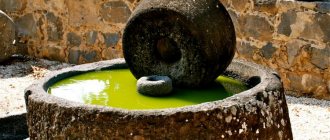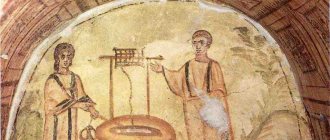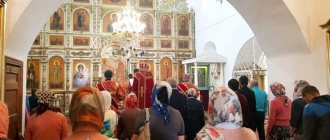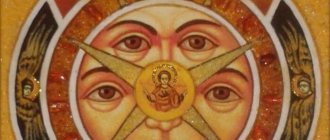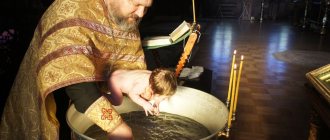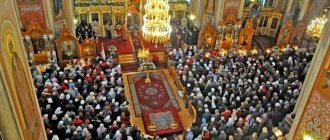Three of the four Gospels contain the story of Jesus Christ praying in the Garden of Gethsemane. Only three apostles become witnesses to the event. Christ is in the most difficult struggle and asks... to carry this cup past Him.
One of the most common icons illustrating the Gethsemane prayer of Christ. The cup of suffering is depicted, the Lord praying and the apostles sleeping in the background. Photo: static.wixstatic.com
Biblical narrative
Mark has a detailed story about this. The fact is that Mark set forth in the Gospel the oral memories of the Apostle Peter. Namely, Peter was one of the eyewitnesses of this prayer:
“And he took with him Peter, James and John; and began to be horrified and sad. And he said to them: My soul is sorrowful unto death; stay here and watch.
And, moving away a little, he fell to the ground and prayed that, if possible, this hour would pass from Him; and said: Abba Father! everything is possible for You; carry this cup past Me; but not what I want, but what You want.
He returns and finds them sleeping, and says to Peter: Simon! are you sleeping? couldn't you stay awake for one hour?
Watch and pray, so that you do not fall into temptation: the spirit is willing, but the flesh is weak. And, going away again, he prayed, saying the same word. And when he returned, he again found them sleeping, for their eyes were heavy, and they did not know what to answer Him.
And he comes the third time and says to them: Are you still sleeping and resting? It is over, the hour has come: behold, the Son of Man is given over into the hands of sinners. Get up, let's go; Behold, he who betrayed Me has drawn near.”
(Mark 14:33–42)
But Christians claim that Jesus is God incarnate.
Could the Creator Himself “be horrified,” “mourn,” and ask to be spared the suffering of the cross? Surprisingly, it is precisely these “inconvenient” places in Scripture that have always emphasized that the Gospel is true. People never kept silent about the circumstances of Christ’s earthly life, even if they did not understand their significance due to their own weakness.
All events are of great importance, each contains the deepest meaning. God, who created everything, became a perfect man. Those who love life, grieve, cry over the death of loved ones and, more than anyone else, suffer terribly.
The tired apostles are sleeping, not sharing the prayers of their divine Teacher, Judas is approaching with a detachment of soldiers, Christ is praying, shedding sweat like drops of blood
Just the day before, He had resurrected the already decaying body of Lazarus. He commanded the winds and the sea, carried the boat contrary to the laws of space and time, clearly showing that He was the One who established physical laws, created everything from nothing, was before anything that He created existed.
And suddenly - He grieves to death and asks to be delivered from the cross. How can His divine dignity be reconciled with this fact? Whom and why does the Lord God Himself ask?
Prayer for the Cup... (Matt. 26:36–44)
To the east of Jerusalem, through a deep valley flows the Kidron stream, the stream through which sad David crossed, pursued by his own son Absalom. Beyond the stream, at the foot of the Mount of Olives, is the Garden of Gethsemane. Several ancient olive trees have survived to this day: they are now surrounded by a low stone fence. Here our Lord Jesus Christ loved to retire with His disciples; here He often conversed in prayer with His Heavenly Father; here He came, our Savior, after the Last Supper with the Apostles, on the night before His suffering: THEN JESUS COMES WITH THEM TO A PLACE
CALLED GETHSEMANE.
In the paradise of sweets, in the Garden of Eden, the fall of the first Adam took place;
In the Garden of Gethsemane, the redemptive suffering of the second Adam, the Lord Jesus, begins. And how much internal suffering, how much mental torment He had to endure here even before they took Him, before His bodily suffering began - there, in the courtyard of Annas and Caiaphas, in Pilate’s praetorium, and finally on Golgotha, on the cross! Yes, it was a night, the like of which has never been and never will be while the world lasts; it was the night of the dying suffering of the Savior of the world, the most severe and unbearable suffering... AND HE SAID TO THE DISCIPLES: SIT HERE WHILE I GO I’LL PRAY THERE.
Having told the disciples to wait for Him while He prayed,
and taking with Him PETER AND BOTH SONS OF Zebedee,
James and John, He went further into the depths of the garden.
“He did not take everyone, so that they would not fall, but only those who were spectators of His glory” (St. John Chrysostom). They were witnesses of His glory on Tabor, they were present at the resurrection of Jairus’s daughter, and therefore were more capable than others of seeing His humiliation in Gethsemane. The hour of great tribulation, great temptation has come. Jesus Christ BEGAN TO GRIEF AND MISS,
began to be horrified... “He grieves and grieves providentially,” says Blessed Theophylact, “so that they may believe that He is a true man, since it is human nature to fear death.
Death did not enter the human race by nature, and therefore human nature fears it and runs away from it. He also grieves in order to hide Himself from the devil, so that the devil would rush at Him as a simple man and kill Him, and thus be overthrown.” He revealed His whole heart to the disciples: THEN JESUS SAYS TO THEM: MY SOUL IS GRIEVED TO DEATH; STAY HERE AND WATCH WITH ME.
Such words were completely new and unexpected for the disciples, “who were accustomed to seeing their Teacher always peaceful and complacent,” says Innocent, Archbishop of Kherson.
- Not understanding, however, the full importance of these moments, they could not feel the full need for prayer: they set about this holy work, but in such a way that the God-man soon felt that this small society did not correspond to the state of His spirit, and, leaving disciples, went deep into the thicket of trees, “went a stone’s throw away from them,” not so far, and the disciples, with the moon shining, could see Him.” The evangelists depict the Savior's sorrows in Gethsemane in strong terms: Saint Matthew says: “he began to grieve and grieve”; Mark: “began to be horrified and sad”; Luke: “He was in agony, and His sweat was like drops of blood falling to the ground.” The Lord Himself says: “My soul is grieved unto death.” He had known human sorrows before, He wept over Lazarus, He wept over Jerusalem; but all these sorrows were too small in comparison with the burning sorrow with which His soul was now full. AND HAVING GOED A LITTLE WAY, ON HIS FACE,
bowed his knees, fell with his face to the ground,
PRAYING.
.. “When you think,” says Philaret, Metropolitan of Moscow, “that this is the Only Begotten Son of God, who has reigned on the heavenly throne from eternity with the Father and the Holy Spirit and has not now left this throne, - that He, clothed in our poverty, weakness, baseness , throws himself to the ground in prayer in order to seek salvation for us through prayer, and through humility to expose, smooth over and heal our pride, then the amazed thought seeks whether there is a sufficiently humiliated place or position in the world into which a person could humiliatingly plunge himself so that he would not were you too ashamed before this Divine humiliation? After such reflection, how light and sweet our prayerful genuflections and prostrations should be for us, which sometimes seem so difficult for our weakness, and perhaps for our laziness! “He fell on his face,” he fell to the ground... For the sin of Adam, the earth was cursed by its Creator; now the Creator removes the curse from her; falling on his face, with outstretched arms, He seems to kiss and embrace her. He falls and makes it the land of the living, the land of blessing.
“Earth, earth,” exclaims Saint Demetrius of Rostov, “inspire the word: God the Word falls to you with His face as a friend, mourning your previous falling away, and now embraces you again as His sincere one, returned to His bosom!”... “Fell on His face, he prayed” AND SAID: MY FATHER! IF IT IS POSSIBLE,
but for You all things are possible,
LET THIS CUP PASS FROM ME; BUT NOT AS I WANT, BUT AS YOU DO.
.. “When he says: let it pass, he shows his human nature; when he says: not as I want, but as You, he shows His courage and firmness, teaching us to obey God, despite the opposition of nature” (St. John Chrysostom). But what do these supplications and prayers to the One who is able to save Him from death mean, prayers with a strong cry and tears, with a great taut heart? “It is true that torment constitutes a great temptation for all human flesh; It is also undeniable that the torment must have been unspeakably more severe for the most pure flesh of the Redeemer of men, which, as not involved in sin, was incomparably more sensitive to torment” (Innocent, Archbishop of Kherson). “But He endured the very insults and sufferings, not in the imagination, but in their very action,” says Philaret, Metropolitan of Moscow, “for many hours of that same night and the next day, without expressing any fear, with victorious firmness, then with high calmness, with the greatness of silence, then with a word of love and prayer for others, and not sorrow for Oneself. And if in one new mysterious moment he cried out: “My God, My God! Why have you forsaken me? , then immediately covered his cry with a solemn voice: “It is finished!” Could this Lamb, slain from the foundation of the world, run away from His altar? The One “whom the Father sanctified and sent into the world” (John 10:36), the One who from time immemorial took upon Himself the ministry of reconciling people with God, could he be shaken in the work of this ministry by the thought of suffering? If He could have any kind of impatience, then perhaps it was impatience to accomplish our salvation and benefit us. “I must be baptized with baptism,” He says, “and how I languish until this is accomplished!” (Luke 12:50). Why, even before visible suffering, is there grief, pain, horror, sorrow of the soul even to the point of death? What bitterness, what burden did this mysterious cup contain within itself, for which He prayed and passed by, and which at the same time He accepted according to the eternal will of His Father, saying: “However, not as I want, but as You want”? Alas, this is the bitterness of our sins, this is the burden of our guilt before God and the executions we deserve, which the Lamb of God took upon Himself, who takes away the sins of the world, and thus He grieved, grieved, was horrified, was grieved in soul even to the point of death, not because His patience was exhausted, but because with His inner suffering He cleansed our inner impurities.
He atoned for our guilt, satisfied God’s justice, which was irritated with us, and at the same time prayed for our pardon, forgiveness and salvation, and was heard. He grieved not with his own sorrow, but with our sorrow (Isa. 53:3-4). The cup that His Father gives Him would have drowned the whole world if He alone had not accepted, held it, and dried it up.” This is the Son of Man praying, under the weight of sorrows; This is His holy humanity praying with holy feelings, but with the feelings of a man. All human sins, all that the whole world had to endure for its iniquities, all this burden now fell on Him alone. One sin is also grave; What if there are more such sins than sand on the seashore? How could our Lord not faint under this burden of sin? “He saw all the sins of the human race, from the first sin of Adam, to the last blasphemy of the Antichrist and his followers,” says Filaret, Archbishop of Chernigov, “he saw all the ugliness, all their vileness before the holiness of God, and this was reflected in His holy, purest soul in torment unbearable. He, the Reconciler of mankind, now stood before the terrible truth of God, which was carrying out judgment on Him for the sins of mankind, which He had taken upon Himself. The favor of the Heavenly Father was most precious to Him; What was it like for Him to feel the displeasure and indignation of the Heavenly Father! “For He made Him who knew no sin to be sin for us, so that in Him we might become the righteousness of God” (2 Cor. 5:21). The Redeemer of men had to endure all things and be tempted “in all things” (Heb. 4:15). “But the temptations to which the human race is subject are of two types,” says Innocent, Archbishop of Kherson, “the temptation of pleasure and the temptation of suffering. The Son of Man experienced the first temptation in all forms at the very beginning of His ministry, when in the desert he was tempted by the devil. The second, more severe, temptation now lay ahead. It was divided into two: Gethsemane and Calvary. On Golgotha, the Son of Man met the cross, surrounded by all horrors, but open to the gaze of everyone, even His enemies; therefore this cross had to be carried with visible grandeur; but the inner cross of His spiritual suffering, with the expression of human weakness, could not be shown to the unclean gaze of one and all. And so, this inner cross, or, more precisely, this innermost and, perhaps, most painful half of the cross, meets the Divine Crusader in the solitude of the city of Gethsemane and falls upon Him with all its burden to the point that it forces him to bow to the ground and cry out: if perhaps a bowl is passing by! It was a combination of all the suffering and all the deaths of all people.
The suffering of conscience alone must have the cruelty of the torments of hell. For if the rudest person often faints because of the suffering of an awakened conscience, tormented only by the idea of his sinful life, then what kind of torment must there have been for the most pure soul of the God-man when it, in its consciousness, imagined itself covered with the sins of the whole world? It is this very fact that the cup of impending suffering and death was dissolved, filled with human sins, the curse of the Law and the wrath of heaven, that made it so terrible and unpleasant.” To complete the temptation was added a living, irresistible thought that in the depths of God’s wisdom there are means to save people without lifting up the Son to the cross; If only there are means to take away at least some of this unbearable cruelty from this cross, or to postpone this execution for another time. “In aggravation of that internal cross, it was probably given to the devil to act as a servant and prince of the world, just as he once acted to test Job’s virtue. It was not in vain that, at the end of the supper, the Divine Sufferer said: “the prince of this world is coming” (John 14:30) and after that, one might say, he went straight to meet him” (Innocent, Archbishop of Kherson). And now, in the silence of the night, in the darkness of the Garden of Gethsemane, Christ our Savior, alone, covered with sweat, exhausted from mental torment, throws himself to the ground, like the very last of the descendants of Adam, grieves mortally and struggles with temptation: “And, being in struggle, he prayed more diligently,” says Saint Luke (Luke 22:44), “and His sweat was like drops of blood falling to the ground.” The waters of the flood once destroyed the lawless, but did not wash away the lawlessness from the face of the earth. The blood of innocent Abel once fell to the earth, but it cried out to heaven for vengeance; The bloody sweat of the Savior falls, but cries out for release and forgiveness. “And His sweat was like drops of blood falling to the ground.” “But who, Lord, without inflicting wounds on You, wounded You like this? - asks Saint Demetrius of Rostov, and he himself answers: - This is love, love strong as death, for the human race!.. Two feelings at that time fought in the most holy soul of the God-man, our Savior: this is fear and love. The fear of impending terrible torment for the sins of the whole world forces Him to cry out to the Heavenly Father: “Father, let this cup pass from Me!” And love thirsts for this cup of suffering, stretches out its hand to it and says: “My Father!.., Thy will be done!” Fear is strong, love is strong, and these two feelings fight in Him and drench Him in blood! Job says: he who sows wickedness reaps sorrow; and You, our meek and gentle Lord, You did not sow wickedness, but you reap sorrow! Thy word is true: there is one who sows, and there is one who reaps”: we have sown sin, and You reap sickness for us!..
Truly, the diseases of hell overwhelmed His spirit, a sea of sorrows surrounded His soul at this unspeakably sorrowful hour for Him! “Oh, how senseless, how insensitive we are, loving the sins that so tormented the Son of God! What torments, what executions we face, neglecting the torments of our Savior, who languished because of our iniquities! Have mercy, have mercy on us, infinite Mercy! - exclaims Filaret, Archbishop of Chernigov, - through Your suffering we beg You, grant us fear against the sins that so terrified You; fill us with indignation and hatred against the wickedness of our treacherous heart!”... In spiritual sorrow, Jesus Christ stops prayer and goes to his three beloved disciples to console Himself with their presence and prayer and to strengthen them with a word of warning. But He finds them sleeping - out of sadness... AND COMES TO THE DISCIPLES AND FINDS THEM SLEEPING.
A sorrowful feeling, although not clear, but still a languid expectation of the imminent separation, which the Lord Himself had so recently told them about, fatigue after the work of the whole day - all this weakened their bodily strength to the point that they were now completely incapable of prayer.
Peter was also asleep, that Peter, who an hour before had promised to lay down his soul for the Teacher... With a heavy heart, the Lord said to him: AND SAYS TO PETER:
Simone!
Are you sleeping? Or have you ceased to be Peter, the rock of faith? SO COULD YOU NOT STAY AWAKE WITH ME FOR ONE HOUR?
Didn't you say that you were ready to die for Me?
You are already asleep now; what will happen when real danger comes? And this danger is approaching; Do not rely on yourself, WATCH AND PRAY SO YOU DO NOT FALL INTO TEMPTATION.
“I forgive you, because you dozed off not out of inattention to Me, but out of weakness,” says Blessed Theophylact.
THE SPIRIT IS VIOLENT,
your soul, of course, is disposed to fight the coming temptation and is capable, out of love for Me, of overcoming it,
BUT
your FLESH, human nature,
is WEAK
in the face of suffering and disaster.
The very voice of the Savior showed that these words were pouring out from a heart torn by sadness!.. “Who has not experienced the justice of these words of the Lord? – asks Filaret, Archbishop of Chernigov. – When we begin to think about earthly life, so vain, about the afterlife, so threatening for a sinner; how many good intentions, holy feelings, great enterprises are born in us! This means that the spirit is willing, that the flesh is weak. Poor humanity!..” The Lord departed from the disciples and began to pray again: AGAIN, GOING AWAY ANOTHER TIME, I PRAYED, SAYING: MY FATHER! IF THIS CUP CANNOT PASS FROM ME LESS SO I DRINK IT, THY WILL BE DONE!
The prayer was the same, but a change had already followed in the feeling of the heart of the praying God-man: “you can no longer hear a direct prayer for the removal of the cup of suffering; stronger conviction in the holy usefulness of the cross; the previous thought is silent - “everything is possible for You”; devotion to the will of God is expressed more vividly and fully; and one’s own desire noticeably weakens and begins to turn into unconditional submission to heavenly determinations.” Never before has the unity of Divinity and humanity appeared in Him with such clarity as in this terrible hour. This was the hour of Christ's greatest self-abasement. Thus, the purest, sinless, holy human nature in the person of Jesus Christ voluntarily surrendered to the will of God: the Lord, who withdrew the cup of suffering from Himself as a weak man, accepts it from the hands of the Heavenly Father, as God who is not involved in suffering. His extreme humility prompts Him to go again to His friends in order to find some consolation and reinforcement for Himself in their prayer; His love is also concerned about their weakness, it cannot forget them even in the midst of its own suffering - and He again finds them sleeping! AND
WHEN HE COME, HE FINDS THEM AGAIN SLEEPING, FOR THEIR EYES WERE HEAVY,
and they did not even know what to say to Him in response.
And again He leaves them, and again throws himself to the ground, and He prays even more diligently, sweating blood... AND, LEAVING THEM, HE WENT AGAIN AND PRAYED A THIRD TIME, SAYING THE SAME WORD.
Thus the word of the Old Testament evangelist, the prophet Isaiah, was fulfilled on Him: “I trodden the winepress alone, and none of the nations was with Me” (Is. 63:3). And so, instead of a visible answer to the prayer, an Angel appeared to strengthen Jesus, appearing, it seems, in such a way that the disciples who were nearby could notice that someone was secretly talking with the Teacher. Just as after the first temptation from the devil in the desert, Angels came to the Lord and served Him, so now an Angel appeared to the Gethsemane Prayer Book to strengthen His human nature for the coming suffering, to pacify the troubled and grieving soul, to fill for Him the consolation that He could to have the most trusted disciples from prayerful sympathy, if they were not overcome by the weakness of the flesh. The angel strengthens Jesus - strengthens the One who Himself bears everything with the word of His power! What a wondrous mystery lies in these words! What a truly incomprehensible depth of the Divine humility of our Savior!.. “I would not have known,” says Blessed Augustine, “how great the good deeds and love of my Lord and Savior towards me, a sinner, if He had not revealed to me what they cost Him "
“If temptation happens to us, let us stand before the image of the praying Jesus, look at the cup coming down from above, let us cast ourselves into the dust before the Heavenly Father and tell Him in the words of His Only Begotten Son, let this cup pass by - and from us too; however, not as we want, but as You: “Thy will be done!” And the Heavenly Father will hear our prayer, just as He heard the prayer of the Only Begotten, and peace of conscience, silence of heart will be for us instead of a strengthening angel” (Filaret, Metropolitan of Moscow).
Theological understanding of the event
Theologians have been formulating answers to these questions for centuries, in terrible clashes and mutual anathemas. Today we know this hard-won truth, shown by Christ in Himself. The fact is that Jesus Christ is not only the true God, Creator and Provider of all creation, but also a true Man.
His whole life: moral torment about created people who had forgotten their Creator, pain from betrayal by his disciples and terrible physical suffering on the cross, were not apparent, or endured by the mask, the shell of God, who always abides in constancy.
Prayer for the chalice, painting
His whole life was the life of a Man who had his own will, similar to us in everything, except for sin. But his will remained obedient to God until the very end - and with this she put an end to Adam’s disobedience, returning to all of us the bliss of the Paradise of Sweetness.
But He knew that on the third day He would rise
Of course, he knew, and revealed it to the apostles.
But don’t we know that we will be resurrected? But isn’t a person horrified when he dies? What can we say about voluntarily surrendering oneself to brutal torture and death? So, Jesus Christ is God and Man, having two wills - divine and human, obedient to it.
He was the true, and not a ghostly, incarnate God, and he was resurrected with a body, forever restoring his terrible divine dignity. So that we are resurrected in new bodies, so that we reign with Him.
Theological interpretation
Theologians see in the words of the Gethsemane prayer of Jesus confirmation that He had two wills: Divine (common with God the Father) and human (received in connection with His incarnation). Athanasius the Great believed that Christ’s prayer for the cup “shows two wills: human, characteristic of the flesh, and Divine, characteristic of God; and human, due to the weakness of the flesh, renounces suffering, but His Divine will is ready for it.”
The Gethsemane prayer of Jesus Christ, from the point of view of theologians, was an expression of His fear of death, inherent in human nature.
| When the human will refused to accept death, and the Divine will allowed this manifestation of humanity, then the Lord, in accordance with His human nature, was in struggle and fear. He prayed to avoid death. But since His Divine will wanted His human will to accept death, suffering became free according to the humanity of Christ. — John of Damascus |
Theophylact of Bulgaria in his interpretation of the Gospel of Matthew writes:
| He wants this cup to pass by, either as evidence that He, as a man, naturally turns away from death, as stated above, or because he did not want the Jews to fall into such a grave sin, which would have resulted in the destruction of the temple and the death of the people. He wants, however, that the will of the Father be done, so that we also know that we must obey God rather than fulfill our own will, even if nature urges us to do otherwise. Or for this purpose he prayed, so that the cup would pass by from Him, so that the sin would not be imputed to the Jews, just as Stephen, having learned from Him, prayed for those stoning him, so that it would not be imputed to them as a sin. |
There is an opinion that during the Gethsemane prayer the devil, who had departed from Jesus “for a time” after His temptation in the desert (Luke 4:13), again approached Him with temptations, trying to divert Him from the upcoming feat of the Passion of the Cross.
St. Maximus the Confessor strongly disagrees with the version of the sinful resistance of Christ’s humanity. He refutes the Nestorian thought of the Monothelites that the human component of the will of Jesus Christ manifested itself not from the moment of his incarnation, but only at the moment of prayer for the Cup and was rejected by the Divine component of his one theanthropic will: “Is there resistance when (Christ) prays and voluntarily accepts carnal weakness through tightness (sustolhv) and does not resist at all, but says: If it is possible and not what I want, but if what You want and adds to the tightness a strong impulse against death? He really captured ours in Himself, through a short-term natural struggle, in order to free us from it, and to confirm the nature of His own flesh...”
For the perfect human essence assumed by Christ (nature, identical to nature among the Chalcedonians and Severians), conscious resistance to God is inconceivable. This is confirmed by the fact that resistance is always “unnatural”, and as such sinful. And in the humanity of Christ, which exists “according to nature,” as St. Maximus the Confessor repeatedly emphasized, there is no active sin. Unlike the Platonists and Neoplatonists, following the Stoics, Justin the Philosopher and the great Cappadocians, St. Maximus always places a very high value on human nature, in particular, and on matter and created nature in general; after all, this nature, as God’s creation, is extraordinarily good (“very good”).
Iconography
The iconography of this plot has the deepest theological meaning. The most ancient icons that have survived to our time date back to the 11th century and are the works of Byzantine Orthodox icon painters.
The icons depict not only the mentioned apostles and Christ, but also an angel. Evangelist Luke narrates this episode in his story about the Gethsemane prayer (22:40-46): “When he came to the place, he said to them: Pray, so as not to fall into temptation.
Prayer for the Cup in the Garden of Gethsemane
And He Himself went away from them about a stone's throw, and, kneeling down, prayed, saying: Father! Oh, that You would deign to carry this cup past Me! however, not My will, but Yours be done. An angel appeared to Him from heaven and strengthened Him.
And, being in struggle, he prayed more diligently, and His sweat was like drops of blood falling to the ground. Rising from prayer, He came to the disciples and found them sleeping from sadness and said to them: Why are you sleeping? stand up and pray so that you will not fall into temptation.”
Theology icons
Icon of Christ the Savior. 3 types of iconography of Jesus Christ
This episode was discussed by more than one generation of holy fathers. At the V Ecumenical Council they consolidated the Orthodox understanding of this event.
The appearing Archangel Gabriel gave God the praise due to Him, glorifying not only His Divine strength, but also the transcendental human fortitude that He showed by becoming a Man. The Archangel set an example for subsequent generations of Christians in glorifying their Creator, who offered Himself for people.
Subsequently, Catholicism, which fell away from Orthodoxy, began to deviate from the theology of the icon towards painting. So in the West, images with plump angels began to appear, as if exhorting Christ to fulfill the will of God for Him. Of course, Christ, being God and Man Himself, did not need this.
“The Prayer of Gethsemane” by the Italian Louis Caracci, 16th century. - an example of a depiction of a gospel event in the West. The icon “Prayer for the Cup” takes on a completely different theological meaning: the angel does not glorify God, but seems to indicate to Christ the will of God about Him. Photo: cdn.gallerix.asia
Researchers of the theology of icons even note the appearance of notes of pagan myths in the images of Western artists. The increased popularity of this topic has also affected Christian subjects.
Thus, the angel who appeared began to resemble Hermes with the apple of discord, revealing the will of the gods to Paris, and the cup in these images is depicted in the hands of the angel. He no longer glorifies, but condescendingly and reproachfully points out to the hero the higher will that he must fulfill.
Let us not proudly brand Western artists as pagan and uncanonical. If only because the tradition extends to Russia, which, as we know, opened a window to Europe under Peter I.
Icon "Last Supper"
Prayer before the icon “Prayer for the Chalice”
How does prayer in front of this icon help? The traditional answer to this neophyte question is simple. Any prayers before any Orthodox icons are known to God before our prayers.
You can and should pray in front of any icons; the location of a person’s heart is important. The icon helps to raise the mind to God. Remembering the events depicted in the icon, we pray to God, who became a man and suffers much more than us.
Painting of a modern Russian temple. The influence of the Western school is visible, distorting the theological meaning of the event: the angel here does not glorify the Creator, but seems to reveal the will of God to Christ, who did not need it. Photo: voznes.ru
In fine arts
The prayer for the cup is one of the popular subjects in Western European painting. Usually, when depicting this plot, artists strictly followed the gospel narrative and depicted a praying Christ, an angel with a cup in his hand, three sleeping disciples and Judas and guards walking in the distance.
The artists sought to emphasize the tragic loneliness of Jesus Christ in the prayer for the cup. He, kneeling, is always the center of the composition, Judas and his guards were placed in the background, and the sleeping disciples in the foreground, emphasizing with their sleep the significance of Christ’s words addressed to them: “Watch and pray, so as not to fall into temptation: the spirit is willing.” , but the flesh is weak” (the sleep of the disciples is contrasted with the wakefulness and prayer of Christ).
In iconography, instructions for writing Jesus praying in Gethsemane are contained in “Erminia” by Dionysius Furnoagrafiot (early 18th century):
| “In the midst of a helicopter town with trees, Christ stands on his knees, raising his hands and eyes to the sky. Bloody sweat drips from His face onto the ground. Above Him in the light an angel is visible, stretching out his hands to Him. Behind Christ, Peter, James and John are sleeping: but the Savior came up to them, and with one hand he wakes up Peter, and in the other he holds a charter with the words: “Was it not possible for you to watch with Me for one hour?” |
Prayer before the icon
There is no special prayer sequence before the image. Satisfying the need for communication with God, in difficult moments of deep heartfelt sorrow, it is possible to pray in any words from the bottom of my heart, remembering the words of the prayer that the Lord said:
My Father! if possible, let this cup pass from Me; however, not as I want, but as You...
(Matt. 26, 39)
Thus, one seemingly very small fragment of each icon, a small mention in the Gospel, reveals to us the great depth of God’s revelation about Himself.
Remembering the very first commandment, which instructs us, among other things, to cognize the Revelation of God, let us reverently comprehend the greatness and depth of the eternal books of the Gospel, once written by fishermen who became fishers of human souls for all centuries.
By leaving a comment, you accept the user agreement
Where to hang it correctly
An icon with a biblical story. Prayer for the cup has high religious, spiritual and material value. Christians treat handwritten ancient copies with particular care. Such icons are kept not only in churches, but also in private collections. All images of Jesus Christ have a visible advantage over other images, since God is the Almighty. When arranging icons in a home iconostasis, the icon of prayer for the chalice is placed on the first line or above other Saints.
Important! In Orthodoxy, you need to perform prayer ascensions facing the east. For this reason, our ancestors always hung all church images on the eastern side of the house. According to the canons of the modern church, such rules do not exist; the main thing is that the iconostasis should be freely accessible for prayer services.
The prayer for the cup can be hung in the bedroom or kitchen. This will provide additional protection from negative external influences and bring family members closer to the spiritual Christian life. Powerful image protection protects the house from demonic or witchcraft influence.
To choose a suitable place for the iconostasis with the icon of prayer for the chalice, you should take a closer look at the brightest and most spacious room in the apartment. Any family member should have the opportunity to come up and pray in front of the holy image. In this case, it is best to light a candle or lamp, make the sign of the cross and bow from the waist.
Advice! Experts recommend storing particularly ancient and valuable relics in closed cupboards or ketones (glass boxes). This will help prevent premature damage to the holy image and protect it from moisture and direct sunlight.
You cannot place the icon of Prayer for the Chalice:
- near a TV or audio equipment;
- near photos of deceased relatives;
- near idols, icons or other paraphernalia of non-Orthodox faith;
- along with art paintings, books, souvenirs.
It is better to place the icon on a special stand or on a table covered with a white tablecloth. If possible, towels embroidered in folk or church style are used for this purpose. The room for storing icons should be light and spacious so that you can quickly concentrate on reading the prayer.
Important! The clergy say that the place where the icon will be kept does not matter much. The main role here is played by respect for church shrines, sincere faith and reverence for the biblical commandments. Holy images should not be allowed to be stored in neglect and disorder.
